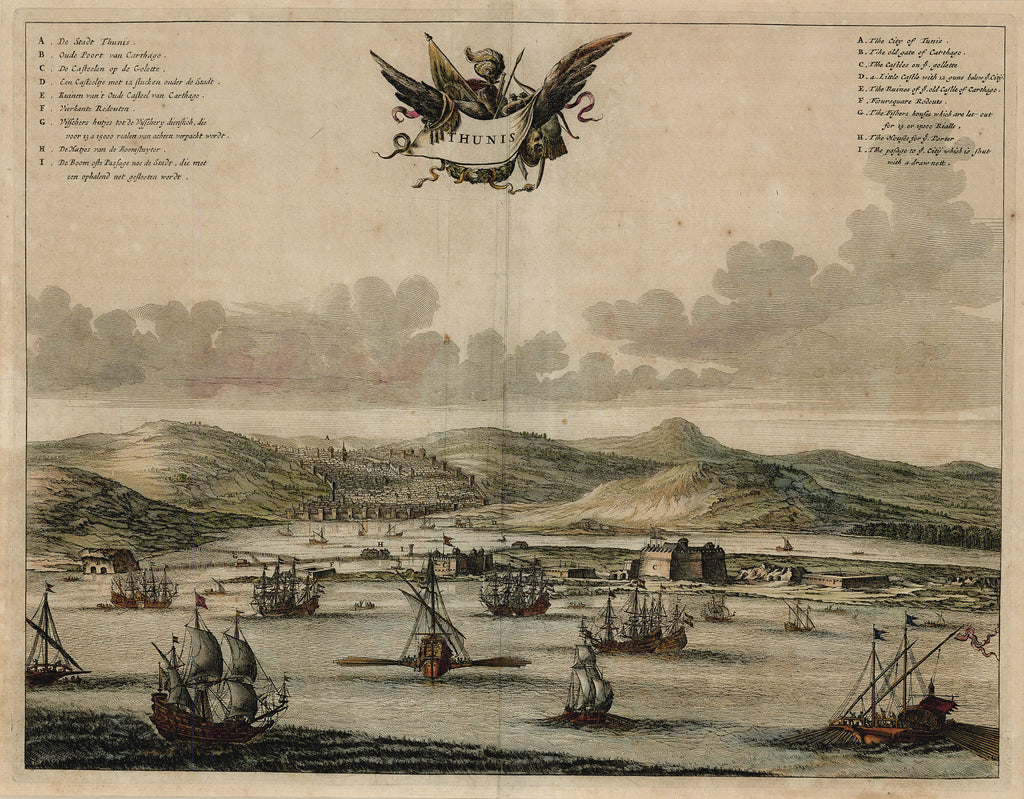- Title: Thunis
- Author: John Ogilby
- Date: 1670
- Medium: Hand-colored copperplate engraving
- Condition: Good - age toning, foxing, wear along issued center fold
- Inches: 13 7/8 x 10 5/8 [Image]
- Centimeters: 35.24 x 26.99 [Image]
- Product ID: 313009
View of the city and harbor of Tunis in Tunisia, North Africa. Includes two legends in the upper corners, one in German and one in English, which indicate major structures and fortifications of the city.
John Ogilby (1600-1676) was a man of many talents. While he remains best known today for his cartographic ventures undertaken in the latter part of his life, he worked in a variety of different professions. In his youth, he apprenticed under a dancer until he became injured while performing in a masque for King James I. Following this setback, Ogilby became a dance master himself, running a dancing school in London for a few years before moving to Dublin to found Ireland’s first theater. In 1637, Ogilby was appointed Master of the King’s Revels in Ireland by Charles I, remaining in Dublin until the theater failed due to strains caused by the Irish Rebellion of 1641. Virtually penniless, Ogilby then returned to England in the midst of civil war, embarking on a career as a translator. Despite ongoing political and military tensions, Ogilby produced a well-received translation of the works of Virgil in 1649, and another of Aesop’s Fables in 1651; the success of these established him as a minor poet. In the following years, Ogilby would also publish an illustrated edition of the Iliad, as well as an illustrated Bible.
Unwaveringly loyal to the Stuart monarchy, in the wake of the Restoration of 1660 Ogilby was awarded an important role in the planning and execution of Charles II’s coronation pageant. Following his ascension, the King once again appointed Ogilby Master of the King’s Revels in Ireland. To emphasize his monarchical devotion, Ogilby composed the Carolies, an epic poem divided in twelve books praising the life, martyrdom, and legacy of Charles I. However, Ogilby numbered among the majority of Londoners devastated by the Great Fire of 1666; not only did this disaster destroy all copies of his epic, but it also burned his premises near Fleet Street to the ground, taking his extensive collection of fine books and manuscripts along with it.
Despite the destruction of his livelihood, Ogilby rebounded successfully, and in 1669 proposed the ambitious publication of an international English Atlas in five volumes: Africa, America, Asia, Europe, and Great Britain. However, these plans would change slightly due to financial and practical constraints, and in 1670 Ogilby shifted his focus to prioritize an atlas of Great Britain. This work, known as the Britannia, contains perhaps the most memorable of Ogilby’s works, his road maps. These maps, published in one-hundred plates, portray the British countryside in slightly-surreal fashion, slicing the landscape into undulating strips that fold back and forth across the page so as to document the entire distance between two cities in a single engraving. In addition to the Britannia, at the time of his death in 1676 Ogilby had published three of his planned foreign atlases: Africa, America, and Part I of Asia. He had also begun a thorough cartographic survey of London, much needed following the Great Fire’s obliteration of nearly two-thirds of the city a few years before.


